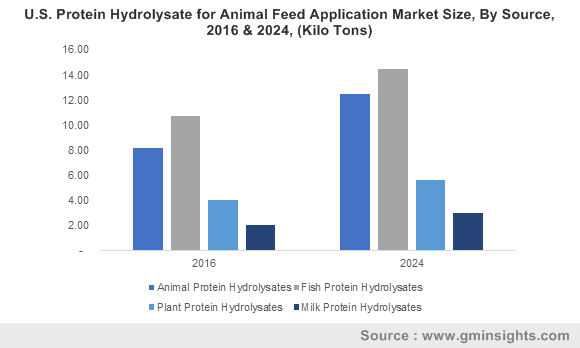Fish protein hydrolysate for animal feed application market to acquire hefty returns over 2017-2024, global consumption to exceed 245 kilo tons by 2024
Publisher : Fractovia | Published Date : 2018-03-22Request Sample
Inherently propelled by the growing interest in protein peptides for animal nutrition, protein hydrolysate for animal feed application market, over the recent years, has observed a substantial momentum. Microbial, enzymic, or chemical hydrolysis of proteins in plant source feed stuffs and animal by products has proved to be an attractive means of producing high quality peptides, that have both nutritional and physiological effect on livestock. In fact, as per experts’ opinion, inclusion of some proportion of soybean protein hydrolysate or animal-protein hydrolysate in animal feed, ensures desirable growth performance of hatching poultry, young calves, weanling pigs, and fish. Thus, it can be aptly inferred that penetration of protein hydrolysate for animal feed application industry has remarkably swayed companion animal nutrition.
U.S. Protein Hydrolysate for Animal Feed Application Market Size, By Source, 2016 & 2024, (Kilo Tons)

It is imperative to mention that commercialization of protein hydrolysate for animal feed application market is majorly influenced by the changing trends of animal feed additives industry. The humongous business space, having been forecast to exceed 25-billion-dollar frontier by 2024, is itself proof enough to the plethora of opportunities of protein hydrolysate in animal nutrition. The marketplace has also gained a traction from the multitude of players partaking in the competitive arena, consistently focusing on expanding their regional prominence. Citing a latest precedent, Arla Foods Ingredients has apparently strengthened its position in dairy protein hydrolysate sector with the opening of its new factory in Nr. Vium, Denmark. Reportedly, this USD 45 million worth plant would be able to produce nearly 4000 tonnes of casein and whey hydrolysate per annum.
Coming to the source portfolio of protein hydrolysate for animal feed application market, fish protein hydrolysate has indeed turned out to be an opportunistic investment spot for potential contenders. Statistics depict, a huge amount of marine fishes are utilized in sea food sectors annually, leading to an accumulation of approximately 100,000 tons fish byproduct /year. The mammoth chunk also includes small fishes that do not match up with the quality criteria and are deployed in industrial process. These low valued fishes, despite containing essential amino acids and proteins, are usually discarded from aquaculture sector and fisheries. According to FAO (The Food and Agriculture Organization), more than 35 million tons of whole fish are annually castoff in commercial fisheries.
Hydrolysis of fish protein has proven to be a viable strategy for economic gain by converting fish processing waste into high value products, with an improvement both in quantity and quality. In fact, numerous research works over the years, unanimously revealed that low valued marine fishes have the potential to be utilized as a protein source for formulating protein hydrolysate. Statistics further backing it- overall fish protein hydrolysate for animal feed application industry is forecast to exceed a valuation of USD 320 million by 2024, as per Global Market Insights, Inc. Regionally, APAC is claimed to witness a prominent hold on this particular business vertical, particularly on account of its expanding aquaculture industry. With the growing appetite for sea food in China from aquaculture and fishing, APAC protein hydrolysate for animal feed application market is expected to exceed a valuation of USD 260 million by 2024.
Speaking of its growth prospects on a global scale, protein hydrolysate for animal feed application industry is forecast to surpass a revenue of USD 835 million by 2024. The business space is strongly characterized by R&D developments, in a bid to expand and enhance its application ranges. Recently, a team of researchers from renowned Sao Paulo University in Brazil have examined that swine liver hydrolysate in varying amount can be used as a substitute in carnivorous fish diets. Reportedly, the study evaluated the impact of graded level dietary SLH on the health and performance of farm raised dourado juveniles. As an outcome of the study, it has been suggested that this alternative protein could replace proposed amount of fish meal in the diet, without any noticeable undermining on the growth quotient. Though more research work is needed to examine the effect of ultra-filter swine liver in fish diets, the study undeniably portrays the extent by which protein hydrolysate have been exploited in animal feed application industry. One of the anticipated trends that remains to be seen in protein hydrolysate for animal feed application market is how the sustainability trend in animal feed and livestock productivity leaves an impact on this business space.